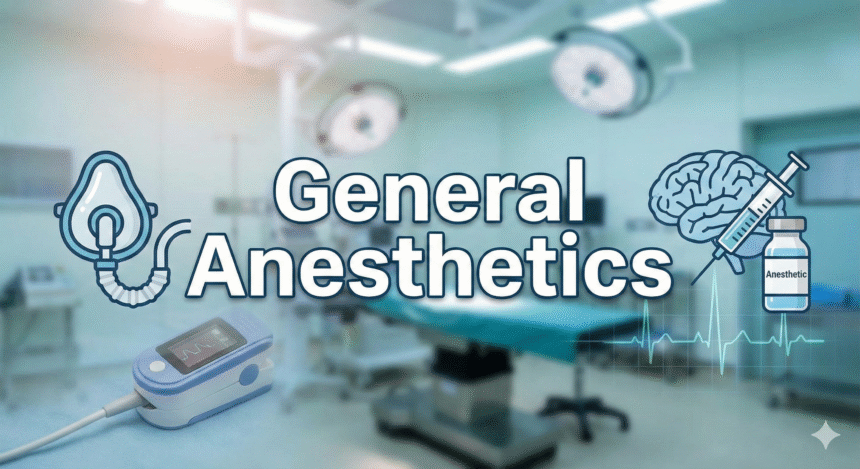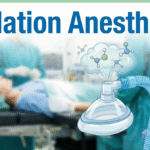Introduction
Understanding General Anesthetics
General anesthetics are a diverse group of drugs used to induce a reversible loss of consciousness, providing pain relief and muscle relaxation during surgical procedures. They play a critical role in modern medicine by allowing patients to undergo complex and potentially painful surgeries safely and comfortably.
Role in Modern Surgery
In the realm of modern surgery, general anesthetics are indispensable. They have transformed surgical practice, enabling a wide range of procedures to be performed with minimal discomfort to the patient. Their evolution has paralleled advances in surgical techniques, contributing significantly to the success and safety of modern operative procedures.
Goals of the Article
This article aims to provide a comprehensive overview of general anesthetics, from their historical development to current practices. It will explore the classification, mechanisms, and types of general anesthetics, highlighting their clinical applications and the considerations involved in their use.
Fundamentals of General Anesthetics
Historical Background and Evolution
The history of general anesthetics is a fascinating journey that began in the 19th century with the discovery of diethyl ether and nitrous oxide. The development of these drugs has been instrumental in the advancement of surgery, evolving from simple inhalation agents to sophisticated drugs used in modern anesthesiology.
Classification of General Anesthetics
General anesthetics are classified into two main categories: inhalation anesthetics, which are gases or vapors inhaled through the lungs, and intravenous anesthetics, which are administered through the bloodstream. Each class has unique properties and uses, determined by their chemical structures and pharmacological effects.
Basic Mechanisms of Action
Despite their varied structures, general anesthetics share a common goal: to depress the central nervous system, leading to unconsciousness and immobility. The basic mechanism involves the disruption of neural pathways in the brain, although the exact molecular mechanisms vary among different agents and are a subject of ongoing research.
Types of General Anesthetics
Inhalation Anesthetics
Inhalation anesthetics, such as nitrous oxide, sevoflurane, and isoflurane, are commonly used for their ease of administration and rapid onset of action. They are particularly useful in controlling the depth of anesthesia during surgery and are often used in combination with other drugs.
Intravenous Anesthetics
Intravenous anesthetics like propofol, ketamine, and thiopental are used for the induction of anesthesia and in procedures where inhalation agents are not suitable. They provide rapid onset and, depending on the drug, can offer additional benefits like amnesia or analgesia.
Comparison and Selection Criteria
The choice between inhalation and intravenous anesthetics depends on various factors including the type and duration of surgery, patient health status, and potential drug interactions. Each class of anesthetic has its benefits and drawbacks, and often, a combination of drugs is used to optimize patient safety and surgical conditions.
Pharmacokinetics of General Anesthetics
Absorption and Distribution
General anesthetics are absorbed into the body through different routes depending on their form. Inhalation anesthetics are absorbed via the lungs, while intravenous anesthetics are directly introduced into the bloodstream. Once absorbed, these drugs are distributed throughout the body, with a particular affinity for fatty tissues and the central nervous system, which explains their potent anesthetic effects.
Metabolism and Biotransformation
The metabolism of general anesthetics varies significantly between agents. Inhalation anesthetics are generally less metabolized and more likely to be exhaled in their unchanged form. In contrast, intravenous anesthetics undergo extensive metabolism, primarily in the liver, transforming into metabolites that can be either active or inactive.
Elimination and Excretion
The elimination of general anesthetics involves excretion through the lungs for inhalation agents and through the kidneys for metabolites of intravenous anesthetics. The rate of elimination is influenced by the solubility of the drug, with less soluble agents being eliminated more quickly.
Clinical Applications
General Surgery and Anesthetic Choices
General anesthetics are selected based on the type and duration of the surgical procedure, the patient’s medical history, and the desired effects (such as depth of anesthesia and muscle relaxation). For example, shorter procedures might favor the use of anesthetics with rapid onset and quick recovery times.
Specialized Surgical Procedures
In specialized surgeries, like cardiothoracic or neurosurgery, specific anesthetics are chosen for their minimal impact on heart and brain function. The choice of anesthetic can significantly influence surgical outcomes and patient recovery in these complex procedures.
Considerations for Specific Patient Populations
Different patient populations, such as the elderly, children, or those with chronic diseases, may respond differently to general anesthetics. Dosing adjustments, careful monitoring, and selection of appropriate agents are essential to minimize risks and ensure the safety of these patients.
Adverse Effects and Safety Concerns
Common Side Effects
Common side effects of general anesthetics include nausea, vomiting, dizziness, and shivering. Most of these effects are short-lived and can be managed effectively with additional medications and supportive care.
Serious Complications
Serious complications, though rare, can occur with general anesthetics. These include malignant hyperthermia, a severe reaction to certain anesthetics, and postoperative cognitive dysfunction. Anesthetics can also impact cardiovascular and respiratory function, necessitating close monitoring.
Monitoring and Managing Risks
Continuous monitoring of vital signs, oxygen levels, and anesthetic depth is essential during the administration of general anesthetics. Preoperative assessment and postoperative care are critical in identifying potential risks and ensuring patient safety. Advances in monitoring technology and anesthetic techniques continue to enhance the safety profile of these drugs.
Drug Interactions and Contraindications
Interactions with Other Medications
General anesthetics can interact with a wide range of medications, potentially altering their effects. For example, interactions with drugs like opioids can enhance respiratory depression. Certain anesthetics may also interact with medications affecting cardiac function, requiring careful management. Understanding these interactions is crucial for preventing adverse effects and ensuring effective anesthesia.
Patient-Specific Contraindications
Certain medical conditions can contraindicate the use of specific general anesthetics. For instance, patients with a history of malignant hyperthermia should avoid certain inhalation agents. Likewise, those with severe liver or kidney disease may require alternative anesthetic choices or dosing adjustments due to altered drug metabolism and clearance.
Precautions in Chronic Diseases
In patients with chronic diseases, such as heart failure, asthma, or diabetes, anesthetic management requires special precautions. These conditions can influence the choice, dosage, and administration of anesthetics. The goal is to minimize the risk of exacerbating the underlying disease while ensuring effective anesthesia.
Recent Developments and Future Trends
Advances in Anesthetic Agents
Recent advancements in anesthetic agents focus on developing drugs that are safer, have fewer side effects, and offer better control over anesthetic depth. Research is ongoing into agents that provide rapid onset and recovery, along with minimal impact on other body systems.
Innovations in Anesthetic Techniques
Innovations in anesthetic techniques include the development of targeted delivery systems, enhanced monitoring technologies, and personalized anesthesia plans based on genetic profiling. These advancements aim to improve patient safety, reduce recovery times, and optimize surgical outcomes.
Future Directions in Anesthetic Practice
The future of anesthetic practice lies in integrating technological advancements with an enhanced understanding of pharmacology. This includes the use of artificial intelligence for monitoring and decision-making during surgery, as well as continued research into the molecular mechanisms of anesthetics to further refine their use.
Conclusion
Summary of Key Points
This article provided a comprehensive exploration of general anesthetics, covering their historical evolution, pharmacokinetics, clinical applications, and safety considerations. The discussion highlighted the critical role of anesthetics in modern surgery and the importance of understanding their interactions and contraindications.
The Evolving Landscape of General Anesthetics
The landscape of general anesthetics is continually evolving, driven by advancements in medical science and technology. As our understanding of these drugs grows, so too does our ability to provide safer, more effective anesthesia. The future promises further innovations that will enhance patient care and surgical outcomes in the field of anesthesiology.
📚 AI Pharma Quiz Generator
🎉 Quiz Results
Medical Disclaimer
The medical information on this post is for general educational purposes only and is provided by Pharmacology Mentor. While we strive to keep content current and accurate, Pharmacology Mentor makes no representations or warranties, express or implied, regarding the completeness, accuracy, reliability, suitability, or availability of the post, the website, or any information, products, services, or related graphics for any purpose. This content is not a substitute for professional medical advice, diagnosis, or treatment; always seek the advice of your physician or other qualified health provider with any questions you may have regarding a medical condition and never disregard or delay seeking professional advice because of something you have read here. Reliance on any information provided is solely at your own risk.









